Often we receive many questions which is the largest military transport airplane in the world. All of these military airlifters mentioned here are incredibly large. Our analysis is based on specifications, available data and technical comparison. The main factors are size of the aircraft and their payload capacity. This list do not contains aircraft that are currently under development of at the prototype stage. It includes only operational cargo planes.
Currently top 10 largest military transport aircraft in the world are these:
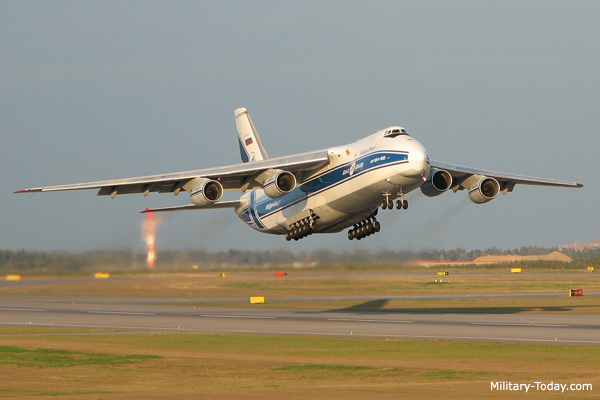
The Antonov An-124 Ruslan (NATO designation Condor) is named after a legendary giant. It is broadly similar to the slightly smaller Lockheed C-5 Galaxy. Currently the An-124 is the world’s largest production military aircraft. Only the one-off Antonov An-225 was bigger, though it was destroyed in 2022 during the Russian invasion to Ukraine.
Development of this long-range heavy transport plane started in 1971. It made its first flight in 1982 and entered service with the Soviet Air Forces in 1987. With its introduction the An-124 has set a number of world records. A total of 54 Antonov An-124 Ruslan aircraft were delivered by 1995. Currently over 40 are in service. Most of these aircraft are in commercial use and only a small number are assigned directly to the air transport arm of the Russian air forces. However there is provision for many civil-registered aircraft to be called into military service if necessary. Russia remains the only military operator of the Ruslan.
This aircraft has a maximum payload capacity of 150 t. The cargo hold of this strategic airlifter can carry virtually any load, including virtually all Russian armored combat vehicles, helicopters, and other oversized cargo.

The Lockheed Martin’s C-5M Super Galaxy is the workhorse of US strategic airlift capability. Also it is the largest aircraft, routinely operated by the US forces.
First operational C-5 Galaxy aircraft was delivered in 1969. A total of 131 C-5 series aircraft were delivered until 1989. About 125 of them are still operational. The C-5M is the latest upgraded version which is faster, has longer range and can carry more payload. United States ordered a total of 52 C-5M aircraft that are being converted from the older C-5 series airlifter.
The Super Galaxy has a cavernous interior with roll-on/roll-off capability. Cargo can be accessed at both ends of the aircraft. It has a maximum payload capacity of 130 t. It can carry two M1A2 Abrams main battle tanks, or 7-10 8×8 armored vehicles (Stryker or LAV-25), or 16 HMMWVs.
These transport aircraft are operated by US Air Mobility Command, Air Force Reserve Command, Air National Guard units. At least two aircraft are assigned to Air Forces Special Operations Command and fulfill a special forces role.
The Super Galaxy aircraft are planned to be operational until 2030.
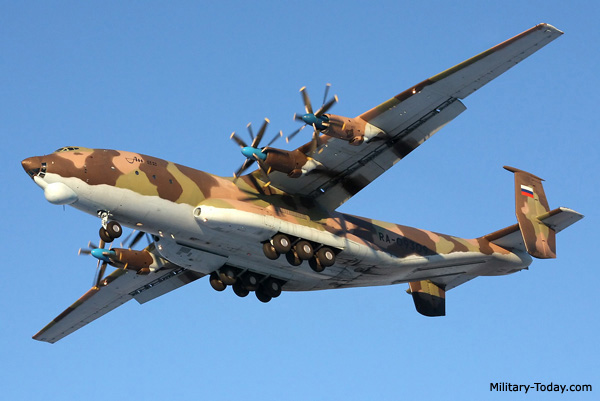
The An-22 is the world’s largest turboprop aircraft. At the time of its introduction in 1965 it was the world’s largest aircraft. The An-22 was extensively used in major military airlifts of the Soviet Union. However it was never produced in large numbers.
This aircraft has a payload capacity of 80 t. It can carry four BMD-2 airborne combat vehicles.
This airlifter can operate from unprepared airfields. It can take-off and land on soft ground.
Currently only 6 of these aircraft are in service with the Russian Air Force. These appear to be operated by an independent military transport aviation squadron. Additional 18 planes are in storage.
The Antonov An-22 outperformed the Boeing C-17 Globemaster III on this list. Technically this aircraft is a bit larger and can carry slightly more weight. Even though the C-17 is a much newer and much more advanced machine.
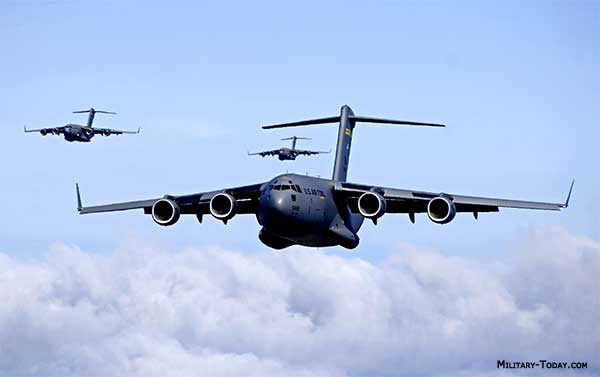
The Boeing C-17 Globemaster III is a workhorse of the USAF, flying regular strategic supply missions around the world. ThDevelopment of this heavy transport aircraft commenced in the 1980s. It made its first flight in 1991 and reached initial operational capability in 1995. It replaced the Lockheed C-141 StarLifter. A total of 250 of these aircraft were built. It is used by US Air Force and some other countries around the world.
This airlifter has a payload capacity of 76.6 t. It can carry M1A2 Abrams tank, or three Stryker 8×8 armored vehicles, or three AH-64 Apache helicopters, or air-droppable platforms up to a weight of 49.8 t. It can also carry a mix of palletized cargo and vehicles. The C-17 can routinely operate from airfields previously denied to jet-powered transports. If required, it can operate from unpaved, unimproved runways.
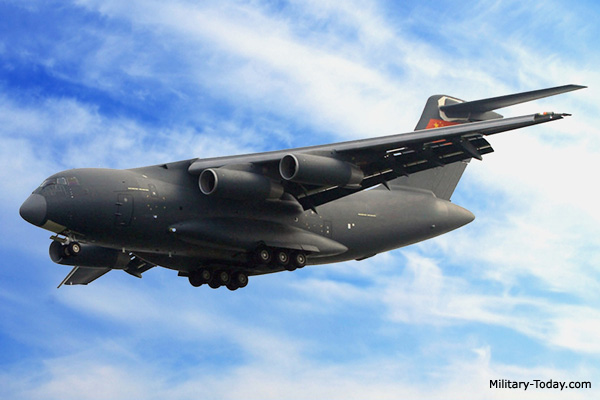
The Y-20 is a new Chinese transport aircraft. It was developed by Xian Aircraft Corporation (XAC) with Russian and Ukrainian assistance. Nevertheless it is the first heavy airlifter developed in China. Development commenced in the 1990s. In 2006 the program became a national priority. The Y-20 made its first flight in 2013. China became the forth country in the world, after United States, Russia and Ukraine, that developed a 200-ton military transport jet. This military transport aircraft entered service with the Chinese air force in 2016.
The Y-20 has a payload capacity of around 60-66 t. It can carry most large combat and support vehicles, including the Type 99 series tanks. In terms of payload the Y-20 fits between a larger Boeing C-17 Globemaster III (77 t) and similar in size Russian Ilyushin Il-76 (50 t). The Y-20 is also superior to the Il-76 in terms of aerodynamic arrangement and performance.
The Y-20 can be even seen as strategic airlifter. It has sufficient range to reach most of the Europe, Africa, Australia and Alaska. Previously China lacked such heavy military transport capability.
Layout of the Y-20 is typical for a modern military heavy transport aircraft. It is powered by four Russian D-30KP2 turbofan engines. These were developed by Solovyev Design Bureau back in the 1960s. It has been reported that in the future indigenous WS-20 engines will be used. Wings for this transport were developed by Ukrainian Antonov Design Bureau. Also it shows some influence of the Boeing C-17 in the tail section and cargo compartment and influence of the Airbus A400M in the landing gear. Composite materials are widely used in the airframe to keep the weigh low.
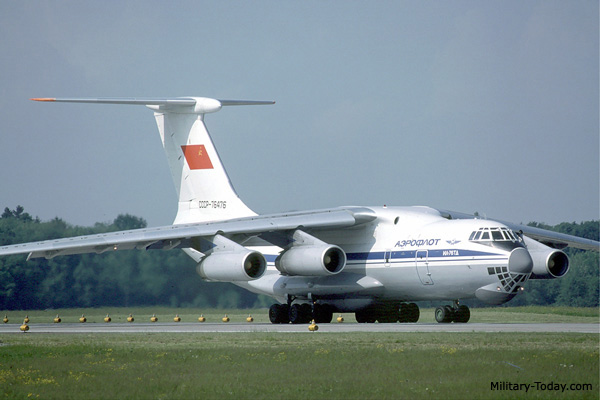
The Il-76 (NATO designation Candid) was the first Soviet four-jet heavy transport. Its production commenced in 1974. Over 800 of these military transport aircraft were built. Together with the An-12 it formed the backbone of the Soviet Airlift Command throughout the Cold War. It was used to fly strategic military cargos into front-line air bases in the most extreme operational conditions. This aircraft is still in service with a number of countries.
The Il-76 has a maximum payload capacity of 50 t. It was designed to deliver heavy vehicles and machinery to remote, poorly-serviced airfields. It can operate from short and unpaved runways. The Il-76 can cope with the worst weather conditions experienced in Siberia and Arctic regions.
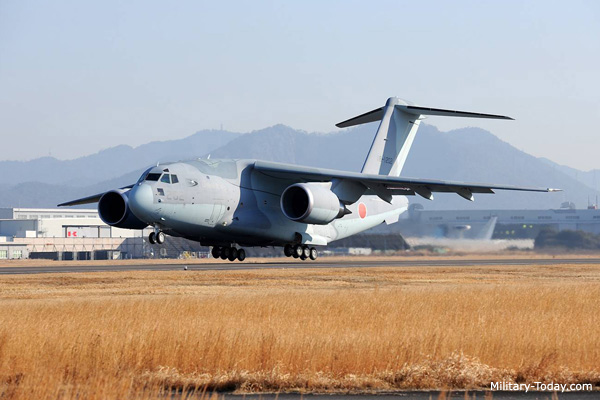
The Kawasaki C-2 is a new Japan’s medium-range military transport. It became operational with Japan’s Air Self-Defense Forces (JASDF) in 2016. Around 30-40 aircraft are planned to be delivered. These will eventually replace a fleet of older Kawasaki C-1 and Lockheed Martin C-130 Hercules tactical transport aircraft.
The Kawasaki C-2 follows the lines of the previous C-1. Its layout is typical for a modern military transport aircraft. In order to decrease development and production costs it was developed in parallel with the Kawasaki P-1 maritime patrol aircraft and shares major airframe parts, basic wing structure and system components. This military transport has similar dimensions and payload capacity to the Airbus A400M.
The Kawasaki C-2 can carry much more cargo than aircraft it replaces. It has a maximum payload capacity of 37.6 t. The older C-1 can carry only 10-12 t and C-130 Hercules – 19 t. The Kawasaki C-2 can carry around 120 troops, or 8 standard air cargo pallets or one UH-60J helicopter.
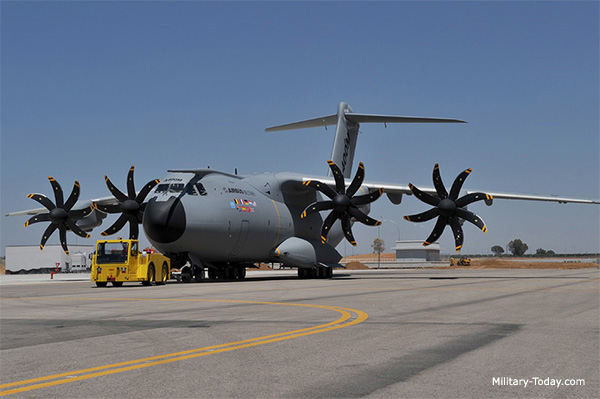
The Airbus A400M Atlas is an international project. This medium-range aircraft made its first flight in 2009. This airplane was ordered by 10 countries. Mayor operators will be Germany (60), France (50), Spain (27), United Kingdom (25) and Turkey (10). First production aircraft were delivered in 2013. The A400M will replace a variety of aircraft, including Lockheed Martin C-130 Hercules and TRANSALL C-160.
Advanced design of the Airbus A400M incorporates extensive use of composite materials. It is fitted with turboprop engines. These engines were selected because of a number of advantages, such as cruise fuel efficiency and lower operating cost.
The A400M has a maximum payload capacity of 37 t. It can carry two 8×8 armored vehicles. This military transport can take-off and land on soft semi-prepared airfields and requires relatively short runways. It was also design to operate with limited or no ground facilities.
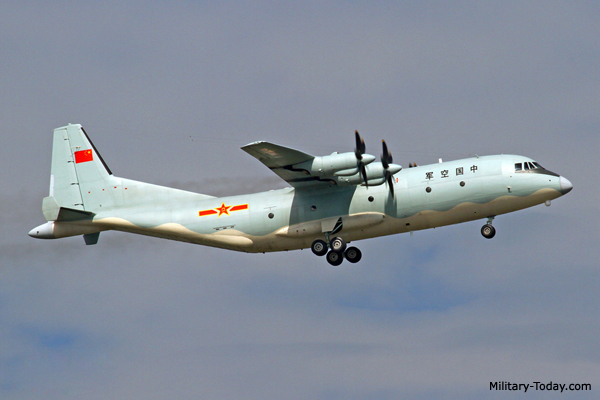
In 2001 development of a new tactical transport aircraft commenced in China. It was designed as a replacement for the Y-8 fleet of transports (copy of a Soviet An-12). Chinese attempted to create a tactical transport aircraft comparable to a US C-130J Super Hercules. Eventually the Y-8 was stretched, improved and upgraded to create the Y-9. This military transport aircraft made its first flight in 2010 and became operational with Chinese air force in 2012.
The Y-9 can carry 25 000 kg of cargo. Though reportedly this aircraft will also take of overloaded with 30 000 kg of cargo. This transport aircraft can carry 106 passengers, 132 paratroopers, or 72 stretchers. Alternatively it can carry two ZLC 2000 airborne combat vehicles, that can be paradropped. The Y-9 can carry various other military vehicles, including light trucks, cargo containers or pallets. The rear cargo door serves as a ramp.
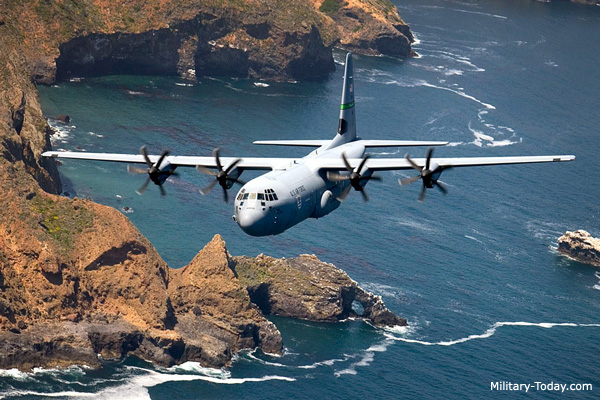
The C-130J Super Hercules was developed by Lockheed Martin. It is the latest production version of the C-130 Hercules. The Super Hercules made its first flight in 1996. It replaced in production the previous C-130H. Deliveries of this tactical airlifter commenced in 1998. By 2014 over 280 Super Hercules aircraft of various models have been delivered to at least 14 countries. Largest operators are the US Air Force, US Marine Corps, Australia, Canada, India, Italy and the United Kingdom. In the Royal Air Force service this aircraft is known as Hercules C5.
This tactical transport aircraft has a payload capacity of 19 t. It can carry 92 soldiers, or 6 pallets, or 2-3 HMMWVs, or a single M113 armored personnel carrier.
Its stretched version, the C-130J-30 has a payload capacity of 20 t. It can carry 128 soldiers, or 8 pallets with cargo.0










